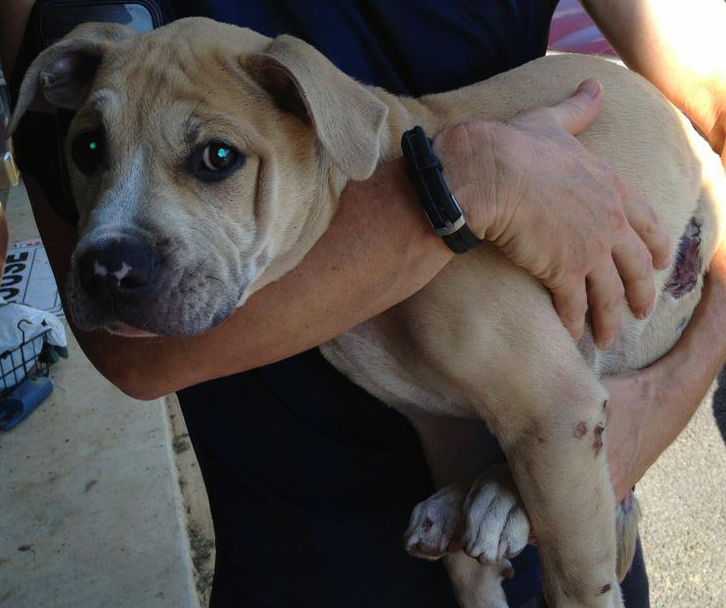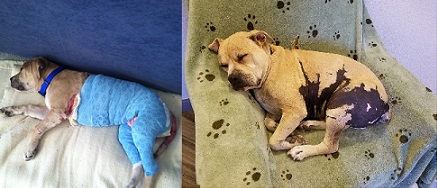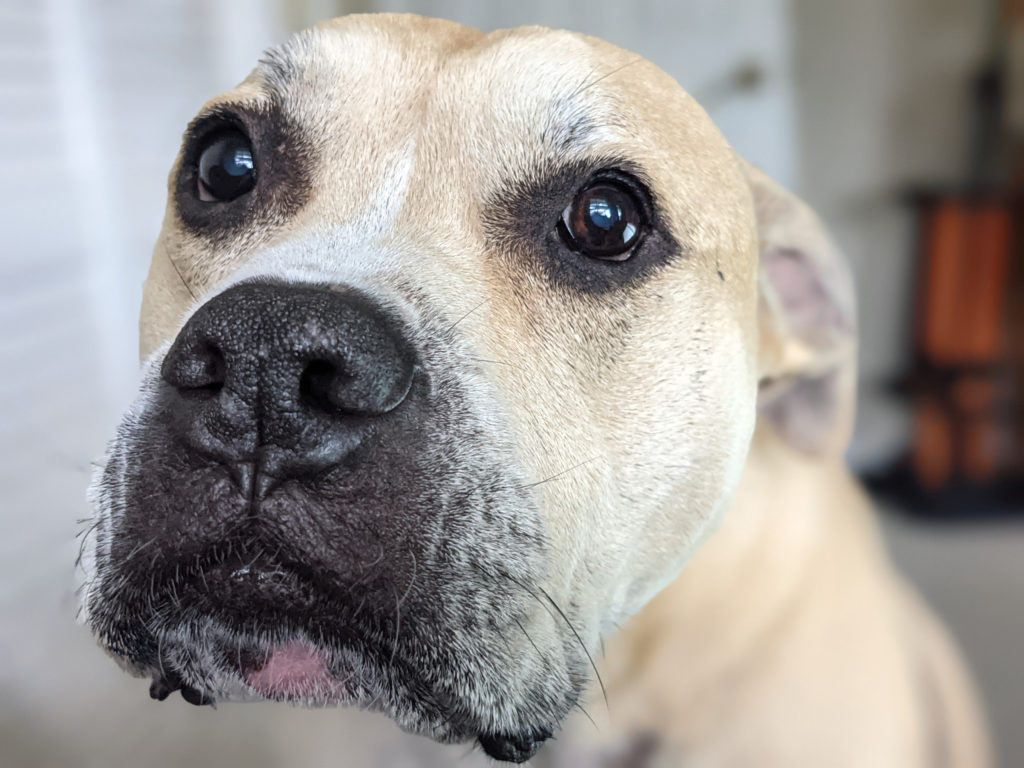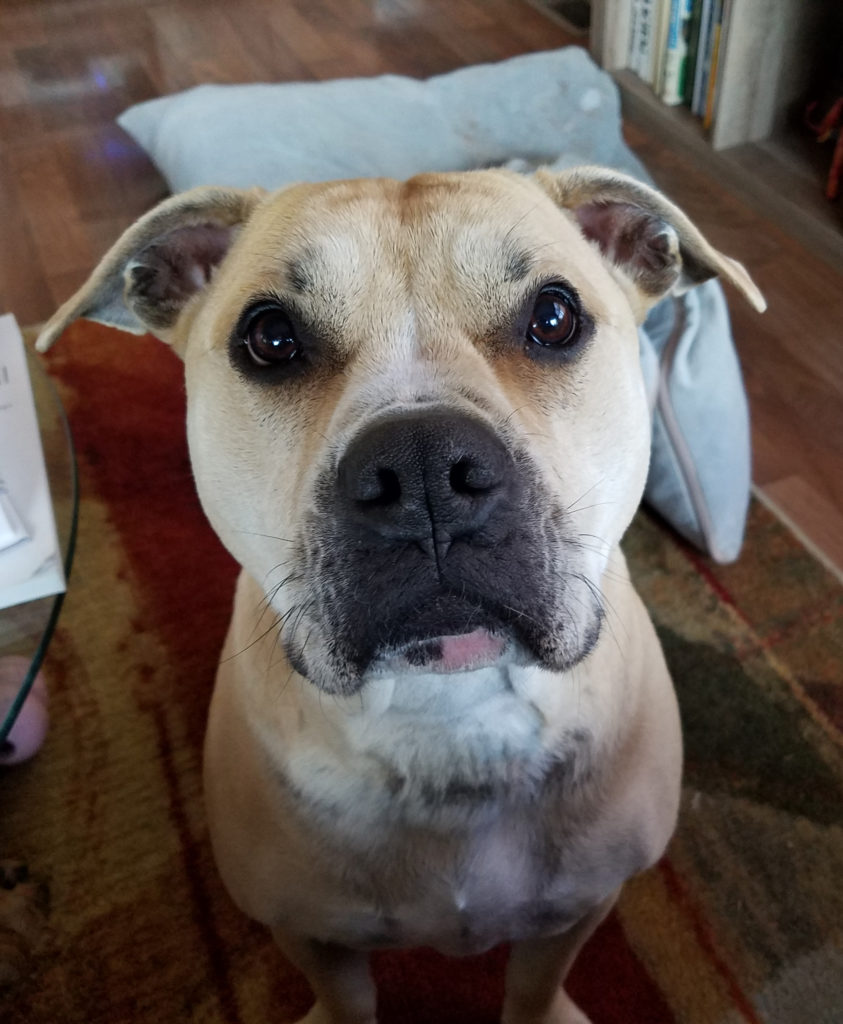Gotcha Day, Every Day

JUNE 15, 2021. Nine years ago today I came upon a wounded puppy standing in the middle of the trail. He was a doe-eyed, bull-headed creature who reeked of rotting flesh as I lifted him to my chest. (We would later learn that he’d most likely been doused with acid.) The veterinarians who examined him later that day feared he would be dead by the following morning.
Not the most inspiring start to our Gotcha Day, that supposedly glorious date of adoption when the newest family member arrives heaven-sent to forever brighten the world anew. That bright new world of ours would have to wait for three bleak weeks of brutal burn therapy and anguished cries and sleepless nights before the pall began to lift. But lift it eventually did, and those shuddering memories have since been buried beneath a velvety sheen of scar tissue and a deepening backlog of joy.
Nine years later I pause when a trim-coated beast of blocky head, barrel chest, and wide chassis enters my study for our morning greeting. Towpath—named for the Chesapeake and Ohio Canal towpath where we met—is now a solid seventy pounds of dog. (His breed, for those who take stock in such labels, is what the DNA analysts at the Mars Wisdom Panel inform us is mostly that of American Staffordshire terrier; or what we laypeople would call a pit bull.) He ambles in with a gait somewhere between a swagger and a waddle, his eyes averted, his bulbous head shyly drooping. There’s the scar, the chocolaty mural of charred flesh that decorates his torso. There’s the waggling stub of what’s left of his tail, long ago amputated in a last-ditch act of triage to lighten the load on his failing organs. He is a living billboard of beauty and brutality.

Between heaven and hell
People of the Dog
AND THAT HAS been the most enduring gift from our gotcha day windfall. Towpath’s wounds reflect the best and the worst of ourselves, but with an inspiring emphasis on the best. The burns have long since become body art, that amputated tail a magic wand of happiness. No matter how grimly those scars speak to the human capacity for cruelty, they more cheerfully speak to the beauty of the bond we share with this particular creature, the dog. Like countless others whose worlds have been so magically elevated by the chance arrival of a stranger, we can no longer imagine, nor bear to imagine, life without.
Such sentimental blatherings. Even while spewing such goo my left brain realizes my right brain has been co-opted, seduced into such fawning over this adorably homely creature. I know very well that Towpath, being a dog, has evolved a special set of muscles rimming his big beseeching eyes, making them appear even bigger, more irresistibly endearing to a certain nurturing element of my human psyche. I know that those eyes, and that big, round, Charlie Brown head of his have been shrewdly selected over the ages to suggest those of a human baby—as in one designed to elicit cuddling and coddling. Even as we trade gazes, our brains are both sending forth euphoric little floods of endorphins, and oxytocin, the same hormone that bonds human mother and suckling infant. I realize the cold biological rationale for why I feel as I do. But is there a better scientific expression for what I feel but love?

The eyes have it: Oxytocin delivery system.
We are bonded to dogs like no other creature in the animal kingdom. We have been courting each other for tens of thousands of years. The mingling began at a critical juncture of human history, as our paleolithic ancestors, fanning out of Africa, were learning to feed themselves by spearing mammoths in the cold open steppes of the Ice Age. Those first dogs were wolves, with one distinct departure: They were those particular wolves who had entered into a partnership with us, a contract of cooperation, marrying the best of our survival skills to our mutual advantage. The wolf-dogs with their legs and noses were practiced at running down big prey; the people with their spears were good at dispatching them. We learned to communicate, through gestures and vocalizations, through eye contact, through those hormonal synchronies of empathy and trust. We hunted together, protected and fed each other. Humanity’s gotcha day with wolves was a pivotal day for both. Together we survived the Pleistocene trial on our way to colonizing the world.
This at least is my favorite candidate among a contentious grab-bag of informed speculations as to how the wolf became the dog, and we became us. It nonetheless fits the more widely held view that those wolves who became dogs were instrumental in our journey to world dominance, and we in theirs. Whether we like it or not, we are people of the dog.
The Ultimate Suffering
WHAT THEN TO make of the scars? We know by his puppy teeth that Towpath was about four months old when assaulted. The fluid pattern of his burns suggests a caustic chemical poured as he lay belly up in the canine body language of surrender, eliciting the mercy that never came. As the acid hit, he reflexively scrunched into the fetal position, as deduced by Rachel Touroo, director of veterinary forensics for the ASPCA, upon examining photos of Towpath’s wounds. Touroo wrote, “The ‘tiger striping’ pattern is likely from Towpath curling up to try to protect himself.”
So much for that sacred interspecies bond of ours. How many hundreds of times we’ve now recited a version of that diagnosis to those strangers who are forever stopping us on the streets to inquire about Towpath’s “interesting markings.” And how many times have we received that same look of shock, that disgusted shake of the head, followed by the rhetorical question, “What’s wrong with people?”
It turns out our chief betrayal of the dog may be less an act of bodily torture than that of the mind. In the more than two million dogs now sitting in the cold confines of America’s shelters; in the two million more now crammed into the cruel cages of America’s puppy mills; in the quarter million more now being hoarded in unloving homes—is a vast and neglected world of emotional pain and suffering.
“While physical suffering gets all the attention, the fact is that emotional pain can cause even more suffering than physical pain,” says the veterinarian Frank McMillan, director of well-being studies with Best Friends Animal Society and author of the textbook Mental Health and Well-being in Animals. The greater pain to be suffered by a dog, says McMillan, is not that of the conventional beating, but that of isolation and loneliness. It is the dog’s deeply entrenched need and longing for human closeness that is not satisfied even by the company of other dogs. Dogs caged in crowded kennels suffer measurably—stress hormones and emotional pains surging—for simple lack of human company. A puppy given a choice of remaining chained alone or crossing an electrified grid to reach his human companion, will regularly opt to suffer the shocks.
What’s wrong with people, indeed. But even as we stand pondering those scars, Towpath opens that Muppet’s maw of his, with its ear-to-ear smile, and starts wiggling that baby’s butt, and suddenly all those cold, cathartic thoughts of violent revenge are soothed in a warm endorphin bath of cooing and petting. Gotcha again.
The Great Connector
These strangers we’ve just met—as much as we are bonding over our mutual contempt for those who would harm such a creature, we are more strongly bonding over our mutual affections for the creature himself. We might be poles apart in our political leanings; we might find ourselves at each other’s throats were we to go there in conversation. Yet so long as we have this ridiculous animal wiggling before us, waving that magic wand, we are family.
As behaviorists note, and as any observant dog companion intuitively knows, dogs are the supreme facilitators of empathy and social discourse. Dogs turn committed wallflowers into master conversationalists, strangers on the streets into instant friends—maybe even warring tribes into comrades in arms.
In dozens of prisons across the country, rescued dogs (a heavy percentage of them looking rather like Towpath) are being matched with inmates in dog-training programs. The dogs and prisoners are teaching each other the ultimate life skill of cooperation. In one ten-week session of dog training in a cell unit at Rikers Island—over a period in which guards predicted there would normally have been thirty or more infractions in this, the most notoriously violent prison in the land—not one violent incident was reported. In a Washington state prison, in a maximum security canyon of razor wire, we find a potentially explosive meeting of rival factions—African American, Latino, and White (the latter tattooed with swastikas)—working together with their dogs, sitting together in the same room and talking.
The success of these programs serves not just as indictment of the American prison system, but as validation of the compassion prescription. “It’s quite striking,” said the psychologist Stephanie LaFarge, an animal abuse counselor with the ASPCA who was working with the Rikers prisoners when I spoke with her a few years ago. “These men are being taught basic learning theory, behavioral modification principles. Punishment doesn’t work; you reward good behavior.”
But there’s a greater, even existential import to our tenuous relationship with the dog. The dog remains our most intimate link to the rest of the animal kingdom, a kingdom under ferocious assault. Tens of billions of sentient creatures are now suffering in the torturous confines of factory farms, for meat we don’t need and the planet can’t sustain. Their free-roaming counterparts are doing no better. The latest iteration of the Living Planet Index reveals a catastrophically steep slide of non-human life over the last half century, a 68-percent decline in the global populations of mammals, birds, amphibians, reptiles, and fish. These are not just collateral victims of our heavy footed trampling of wild terrain or our industrial mining of sealife. Many among the disappearing are subjected to concerted campaigns of annihilation. Even as I write, we have a certain culture in this country now waging war on wild predators, with our most insidious tortures and betrayals reserved for the wolf, the very creature who gave us the dog.
Together these atrocities are contributing to the 6th mass extinction in the history of life on Earth, the first to be engineered by a single form of life. No ecologists that I yet know of are offering any reasonable scenarios in which we gracefully survive it. It’s this widening gap in our empathy with the living world that portends the Hobbesian specter of a nasty, brutish, and short outlook for humankind.
Yet once again, it’s neither the entire nor inevitable picture. In our bond with the dog remains that thread of hope for somehow closing the gap—a bridge back to that diverse and wondrous world of life that both birthed and sustains us.
NONE OF WHICH concerns me right now. Today as Towpath enters my study, I’m transported as always by that waddling swagger and waggling nubbin. I caress that elegant fresco of scars, and coo into that big smoochable mug of his. But what I find myself keying on today is something less sanguine. It’s his muzzle, subtly but surely fading from fawn to white.

Attention, please. Somebody is hungry.
I suppose the journalist should somehow find it symbolic, that same white harbinger of mortality invading both his pelage and mine. Yet the message it now conveys is more simply that of terror. In that aging face is the promise of a particular morning hurtling forth, when the world is suddenly and irretrievably empty of him. Or maybe the journalist should look to the science, to rationalize that illogical phenomenon of we odd humans who would grieve more for the loss of a dog than for one’s closest kin. But there’s no comfort there either. My own creeping demise I can handle; his I cannot. It’s the devil’s bargain we’ve struck, the heartbreak of loss as final payment for all those moments of togetherness we’ve leased.
But once again, there’s that blessing in the bargain. In that unbearable end rushing forth is the constant reminder to appreciate the priceless moment before us, to realize every day as gotcha day.
That reminder is now staring me down with those big beguiling eyes. Once he’s hooked me, Towpath turns his naked butt to my face and wiggles away, peeking back as he goes to make sure that his subject is following. It’s his perverted version of the honeybee’s waggle dance; he’s directing his fellow hive mate to the nectar—which in this case, he means to remind me, is the food bowl I’m late in filling with his morning’s breakfast.
And I’m more than happy to oblige, forever grateful to be so helplessly taken by this charming soul. It’s gotcha day.
###
From the archives: Here’s last year’s video tribute to our gotcha day:
I have followed Towpath from the very first time I read about him. I just love that no matter what some lunatic did to him, he is wagging his tail today saying I made it., I am happy and have a great life. He is strong and his story hits my heart. I sit here looking at my sweet baby, (a rescue) and see the love in his eyes. I often wonder what he went through and than I realize that he is mine and the love we give to each other is forever.
Thanks for your thoughts, Laura. Pretty special to have such creatures in our lives.
Another piece of masterful writing from Will. Thanks for making me look at so many sides of an issue, with such depth and candor.
Great to hear from you, Denise. I know you guys went pretty deep into this with Goldie.
How can it be nine years already? As always, A moving read, Will. Having a few weeks ago suffered loss after 16 years of companionship, and loss before that, and loss before that, and surely more loss to come, I know that no matter the warning signs, the white muzzle, the increasingly complex array of medication taking up an increasing amount of counter space, we’re never ready and always able to convince ourselves that it will not come soon. And when it does come, the proverbial ton of bricks. But not Towpath, he shall live forever, even when physically he is no longer here.
Hugs for this, Harry. You know far more deeply than I do about what I’m trying to say with this piece.
Hi, Towpath! xoxo from your SYSS friend! Will, a beautifully written piece on doggie love. #TowpathForever
Hi Laura! Thanks for your nice note. Hail to those special pups in our lives.
Such an incredibly moving piece that reminds us of our (in)humanity and the brutal contradictions that bring me to my knees daily. I know who is going to greet me on the other side of the rainbow bridge. There is never enough time with our beloved companions. And as Victor Hugo said: “Animals run no risk of going to hell, they are there already” (except for those that are lucky enough to be loved by compassionate humans). Thank you for this beautiful piece.
Never enough time indeed. Thanks for the kind words, and for all you do for the animals.